Airs Above the Ground
Airs Above the Ground
Jean Luc Cornille
2013
When I came in America, I was very surprised to realize that the airs above the ground were regarded as the high end of the high school. They are not and they are never meant to be. The high school is about higher level dressage movements creating higher elevation of the gaits such as Passage, Piaff and also dressage movements demanding higher level of balance control such as Canter Pirouette, Tempi Changes, etc. The airs above the grounds are a special branch which have been created first to entertain the nobles and later, when the military took over, they perpetuated the practice of the airs above the ground to develop the riders’ skill. In fact, the training of the airs above the ground is more like a circus trick that what is referred to as academic equitation.
The best definition of Academic Equitation has been made by the Duke of Newcastle, “Perfecting nature through the subtlety of the art.” Dressage movements are stylized version of natural movements. They cannot be trained through natural reflex like most equestrian theories pretend, but instead through deep understanding of the horse’s physiology and how to develop and coordinate the horse’s physique for the specific demand created by the stylization of a natural move. Basically, dressage and jumping performances are idealizations of natural motions including the airs above the ground.
However, there are performances that have been created to entertain the riders’ ego and the public, which are in complete contradiction with the way the horse’s physique is constructed. To take simply two examples I will refer to the sliding halt of the western world and the Levade of the airs above the ground. The hocks can manage considerable forces as long as they are used for what they are supposed to be used, which is flexion immediately followed by extension. The hocks can propel an 1800 pounds athlete over a 6 feet jump and they can recover balance during the stride following the landing. They are not designed to absorb tremendous stresses while being held in full extension such as during the western sliding halt. They are not designed either to support the horse’s weight while being held in half flexion such as during the Levade.
Another legend regarding the airs above the ground is that they were originally “war manoeuvers.” This is not true either. They have been created to entertain the public and show the skill and stability of the riders’ seat. At Saumur, which was at this time a military school, the airs above the ground were practiced and still are today, to develop the riders’ aptitudes. Therefore, the airs above the ground are practiced without stirrups using a specific saddle. 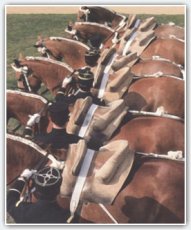
They are also presented into a more martial style. The Courbette for instance is presented as a single rearing where the rider remains perpendicular to the horse. 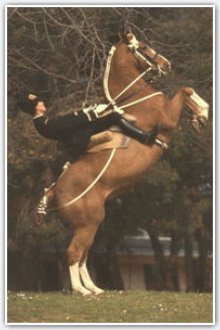
The courbette of the Spanish Riding School is a succession of three jumps that the horse executes while being in balance on his hind legs. This is a quite difficult movement to execute for the horse and for the rider.
The croupade, 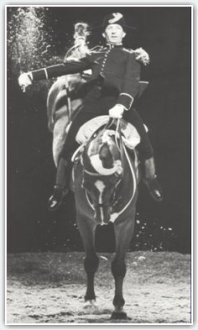 which is a violent quick, is challenging for the rider. The education of the croupade commences between two pillars. The rider absorbs the violence of the quick through the flexibility of the vertebral column throwing his upper body backward. This movement is effectively a good gymnastic exercise. The first time one practices the croupade between the pillars, one flies quite high and far away from the horse and if lucky between the two pillars. The ones who are less lucky crash against the pillars. The game at Saumur is to draw a line in the sand and the student who flies the further away is the winner.
which is a violent quick, is challenging for the rider. The education of the croupade commences between two pillars. The rider absorbs the violence of the quick through the flexibility of the vertebral column throwing his upper body backward. This movement is effectively a good gymnastic exercise. The first time one practices the croupade between the pillars, one flies quite high and far away from the horse and if lucky between the two pillars. The ones who are less lucky crash against the pillars. The game at Saumur is to draw a line in the sand and the student who flies the further away is the winner. 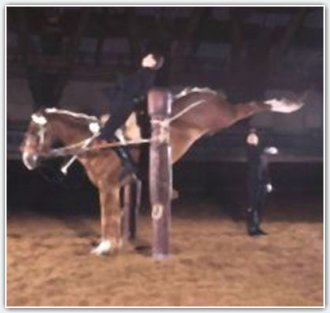
Once the student graduated, which means once the student remains on the horse, the croupade is executed in hand and riding the horse. Both the Courbette and the Croupade prepare the horse for the Cabriole. The horse is then asked to perform a very collected canter named “terre a terre,” From this canter, the horse is asked to perform the “Courbette” and as soon as the horse starts rearing, the rider ask for the “Croupade.” The horse jumps in the air and quick as he is at the top of his trajectory.
The Saumur “Cabriole” is more demanding for the rider than the Vienna School’s “Capriole” which is executed during the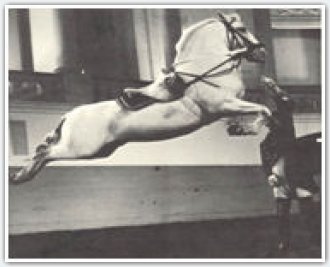 ascending phase of the jump.
ascending phase of the jump.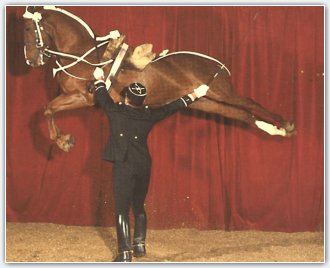
(On left Jean Luc Cornille)
There are mostly three schools which are practicing the airs above the ground. The “Cadre Noir de Saumur”, The Vienna “Spanish Riding School” and the “Real Escuela Andaluza del Arte Ecuestre” in the south of Spain under the leadership of Mr. Alvaro Gomez. These schools have great experience about the physical demands of the performances. At Saumur, the horse are Selle Francais and as you can see on the picture they have a very strong musculature. The horse presented is this picture is also a Selle Francais. His name is Caesar. Look at its muscular development. He does not practice the airs above the ground because this is not his job, but any horse asked to perform these movements should be muscularly developed as well as Caesar. At Saumur the same horse practice the three movements. At Vienna the horses are specialized to a single movement and they are breed for this movement. They are selected for their physical aptitude for the move. I do not know how they train in Spain but Alvaro Gomez is a horse person who has a tremendous experience fighting the bulls with horses. Personally I do not like such spectacle but the training of the horses and the skill of the riders is quite extraordinary. (Ceasar and Jean Luc on right)
because this is not his job, but any horse asked to perform these movements should be muscularly developed as well as Caesar. At Saumur the same horse practice the three movements. At Vienna the horses are specialized to a single movement and they are breed for this movement. They are selected for their physical aptitude for the move. I do not know how they train in Spain but Alvaro Gomez is a horse person who has a tremendous experience fighting the bulls with horses. Personally I do not like such spectacle but the training of the horses and the skill of the riders is quite extraordinary. (Ceasar and Jean Luc on right)
There are group and individuals who are doing a good job. The group in Illinoi started quite well under the direction of Karl Mikolka. In Europe, experienced riders and trainers are presenting horses well muscle up and properly coordinated for the athletic demand of the performance. By contrast, many others should have the decency to abstain; the horses have no muscles, they are dysfunctional and physically incapable to execute the move properly. Most of these so-called classic trainers cannot teach a decent piaff but they practice Levade or other moves because they think that the airs above the ground are the high end of the high school. Interestingly, they have it all wrong. At Saumur, when you are a young “Maître de Manege” or “Ecuyer”, you present first the airs above the ground. Later, as you take experience, subtlety and knowledge you graduate for “La Reprise des Ecuyers” which presents the real high end of high school, passage, piaff, tempi changes, canter pirouettes and so on.
Jean Luc Cornille
About Jean Luc
Jean Luc's competitive career is as distinguished as it is diversified. Competing at national and international levels in dressage, steeplechase, stadium jumping and three-day events, he has won extensively in all specialties collecting several gold, silver and bronze medals. Notably, Jean Luc won the individual and team gold medal at the military world championship of Fontainebleau in 1975. In 1971, he won silver at the world championship of Punchestown. The following year, he was member of the winning team at Bokello. However, Jean Luc feels that his greatest success lies in his ability to intuit the physical and mental condition of each horse the day after their victories.
A 1968 graduate of the Equestrian Military School, Le Cadre Noir de Saumur, Jean Luc received intensive training from Joseph Neckerman, Willy Schulteis and Hans Gunter Winkler. In 1972 and 1976, respectively, he worked closely with Michel Cochenet to prepare two Olympic teams for the national three-day event. Margit Otto Crepin, the French and Olympic Champion, is one of Jean Luc's most prominent dressage students.
Moving to the U.S. as dressage trainer for the 1984 Los Angeles Olumpic jumping team gold Gold medal, Melanie Smith at Windrush Farm, Jean Luc subsequently founded E. A. 21 in Orange, Virginia, from which he began an extensive program of clinics and seminars throughout the U.S. and Canada. His work has concentrated on applying the latest biomechanical research to redefine traditional approaches to equine training. It was here that Jean Luc also discovered a strong connection to the rehabilitation of lame horses. He has successfully rehabilitated such severe disabilities as navicular syndrome, contracted tendons, degenerative joint disease, and upward fixation of the patella, as well as cases of obscure and idiopathic lameness.
Jean Luc began his publishing career in 1982 with a series of articles in the French equestrian magazine L’Eperon. His writing credits also include the U.S. magazines Dressage and CT and The Chronicle of the Horse. He continues to share his research and knowledge through clinics and lectures, and as founder of Science Of Motion. He is currently working on a series of text books and educational videos, that will discuss and explore his findings to date. To that end, he has published a series of articles on biomechanics, a video exploring the subject of appling recent scientific discoveries to equine athletes' education.



 twitter
twitter facebook
facebook delicious
delicious digg
digg stumbleupon
stumbleupon linkedin
linkedin